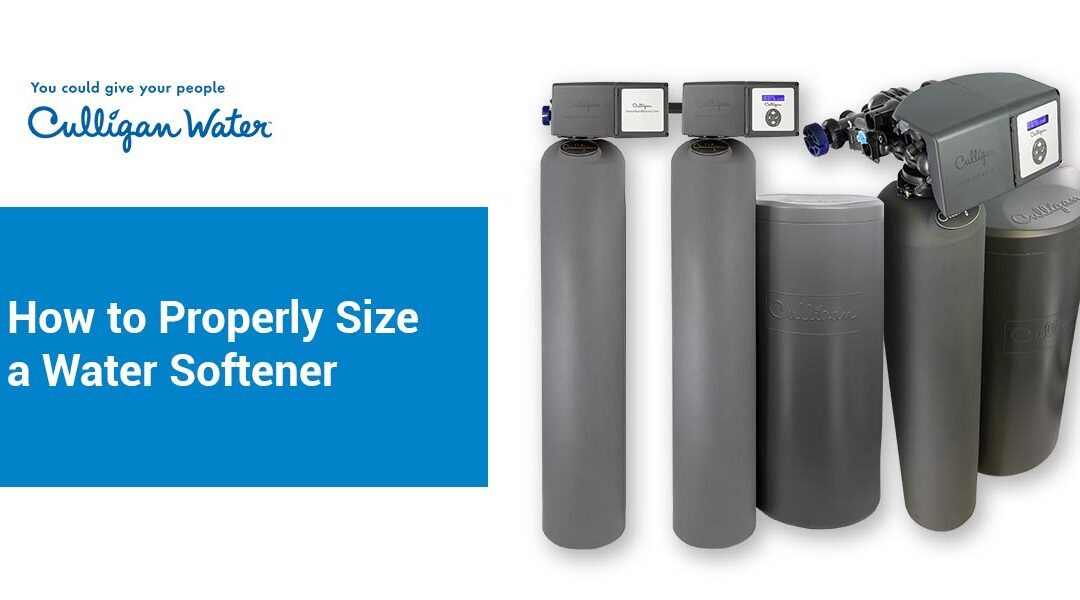Table of Contents
Hard water can affect your home’s systems and have unpleasant effects on your skin and hair, leading to dullness and dryness. If you struggle with stained clothes and buildup on your dishes, showerheads and other surfaces, you can solve these problems by installing a water softener.
Before installing one of these systems, you’ll need to determine what size water softener you need. Having the right size will ensure you can set the ideal water hardness while operating at a reasonable price.
Consider these points when deciding what size water softener to buy for your home, or reach out to a local water treatment expert for help finding the right fit.
Factors That Determine Proper Water Softener Size
If you are considering purchasing a water softener, you should ensure that your chosen model will adequately address your needs. A properly sized water softener can lessen buildup and address other concerns that hard water might cause. You should consider two main factors when trying to figure out how to size a water softener — water hardness and water consumption.
1. Water Hardness
Water hardness measures the concentration of dissolved minerals like calcium and magnesium in your water. This concentration is most commonly measured in grains per gallon (gpg), but you might also see parts per million (ppm) or milligrams per liter (mg/L). If you receive water from a city system, you can determine your water hardness based on the local water utility report. If you find that you also have iron in the water, you will want to add about 3 gpg of hardness for every 1 ppm of iron in the water.
If you are on a well water system or want the most accurate number possible for your house, you can contact a water treatment company to perform at-home testing.
2. Water Consumption
When choosing a water softener, you should also account for your home’s water use. The harder your water and the more water you use each day, the more your softener will need to regenerate, meaning you will need more salt.
You can calculate your water consumption by looking at your monthly water bill to determine the daily average water usage. If you do not have this information, you can typically assume about 50 to 75 gallons daily for each household member.
How to Calculate Softening Requirements
Once you know your consumption and hardness, you can use these numbers to calculate your water softener requirements. You can multiply your water hardness by your household’s daily water consumption to determine the total number of grains your system must treat daily.
For example, you may have determined that your water hardness is 10 grains per gallon. If you have four people in your household and each uses an average of 75 gallons of water daily, your daily water consumption is 300 gallons. If you multiply 10 gpg by 300 gallons, you get 3,000 — the mineral grains your water softener must treat each day.
With this number in mind, you can browse water softeners to find one that meets your capacity needs. For best performance, your softener should regenerate once a week, so having softening requirements of 3,000 grains daily means you need a softener that treats 21,000 grains. You should also account for salt use — If a softener requires many pounds of salt to fully regenerate, you incur higher costs.
Another factor to consider is the flow rate. If you have multiple family members using a system simultaneously, your softener must work harder to deliver soft water to every faucet.
Understanding Water Softener Grains
When browsing available water softener options, you will often see softeners sold as 24,000-grain, 32,000-grain, 48,000-grain or 64,000-grain. Unfortunately, these numbers don’t accurately indicate how many grains they filter because these numbers reflect testing in laboratory conditions, often using large amounts of salt.
A 32,000-grain water softener contains 1 cubic foot of resin. This amount of resin requires about 18 pounds of salt to operate at full capacity, which will often be about 30,000 grains. Replacing 18 pounds of salt every week will result in high annual consumption. Instead, you might use 6 pounds of salt to regenerate your water softener. Using one-third the proportion of salt results in a water softener that operates at two-thirds of maximum capacity, about 20,000 grains in this case.
When choosing a water softener, you should consider the cubic feet of resin the softener contains and the salt used for each regeneration. Here is a more accurate representation of water softener capacity based on cubic feet of resin:
- 24,000-grain water softener: These softeners contain 0.75 cubic feet of resin and operate most efficiently at 15,000 grains.
- 32,000-grain water softener: These softeners typically contain 1 cubic foot of resin, and when working at the highest efficiency, they have an actual capacity of about 20,000 grains.
- 48,000-grain water softener: With 1.5 cubic feet of softener resin, these softeners typically achieve a 30,000-grain capacity at the highest efficiency.
- 64,000-grain water softener: When run with one-third of its full salt volume, this water softener has a 40,000-grain capacity with 2.0 cubic feet of softener resin.
Talk to Culligan Water About a Water Softener
You can use your water hardness and water consumption to determine the proper size of water softener for your needs. Once you discover your daily grains per gallon of minerals, you can match this number to a water softener with the proper grain capacity.
If you are still unsure what size water softener will work best for your property, Culligan Water can help. With a free in-home water analysis, we can help you determine your water’s hardness and find the proper size of water softener for your needs. We also provide maintenance to keep your system in top condition and salt delivery to make running your water softener easier. Schedule your water analysis today to get started.

